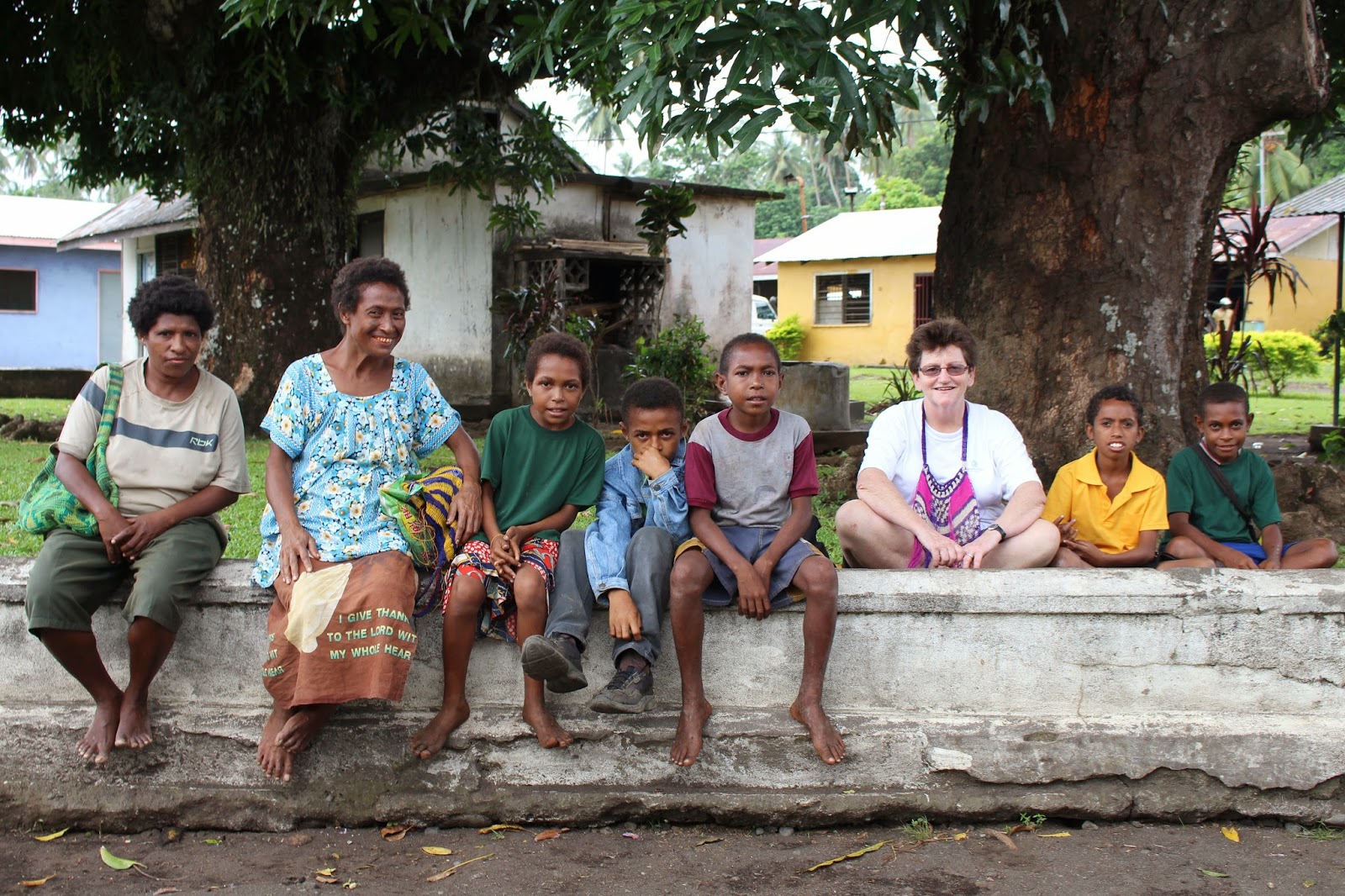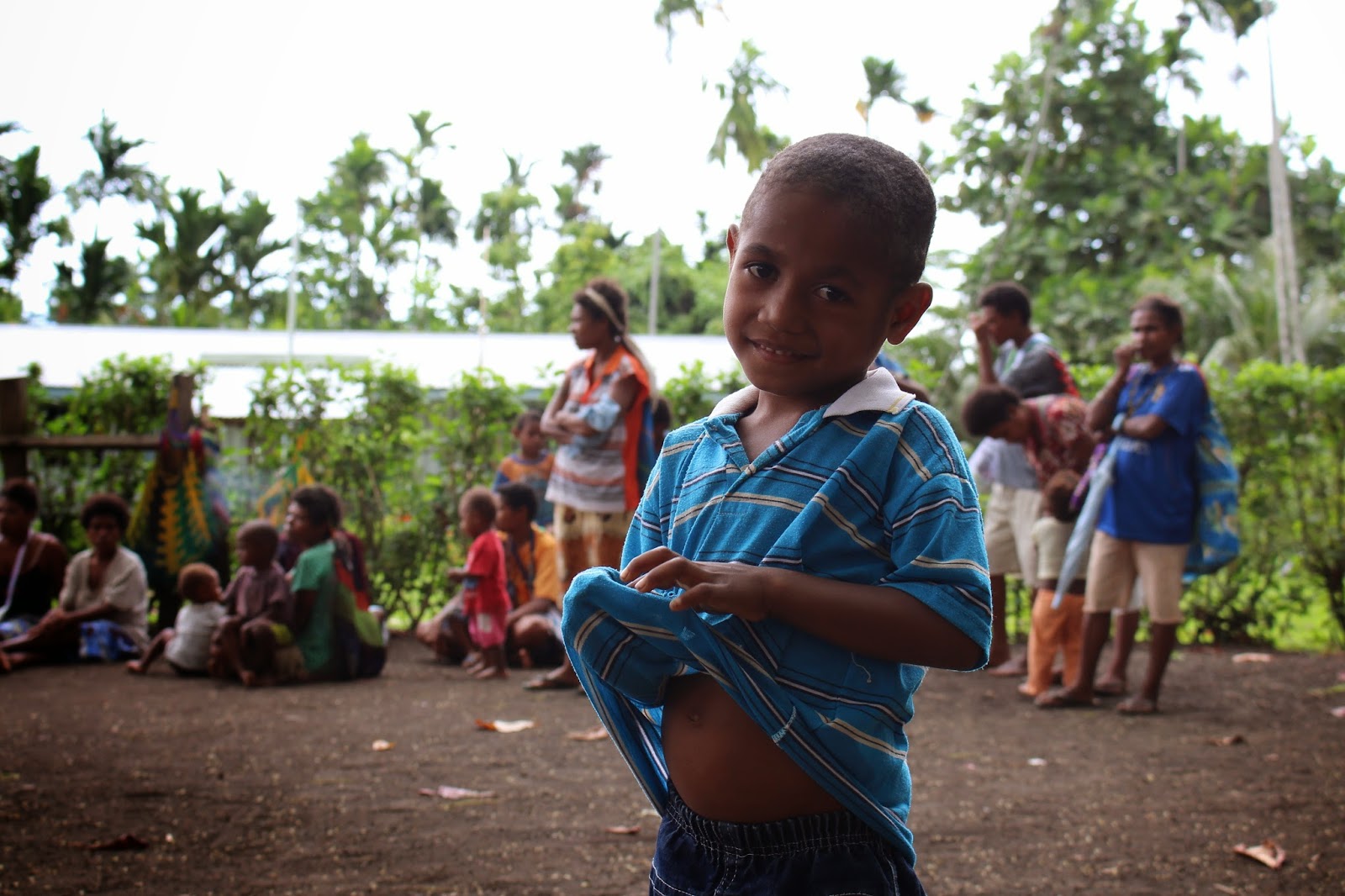PNG Journal Day 7 / Karkar Island - the last day
18:29
Friday, September 19 - Karkar Island
Our time on Karkar Island ended not with a bang, but a
whisper.
The morning began on a hopeful note. The weather was calm
and beautiful. Over a breakfast of tropical fruit, we chatted about marine
wildlife on Karkar. Brett was telling us about what they had encountered in the
waters - green and leatherback turtles to sharks of all kinds – reef sharks,
grey nurse, the occasional school of hammerheads, whaler shakers and less
commonly, tiger sharks. The animals here are not protected, but that also means
that traditional hunting keeps their numbers down without driving them into
extinction.
Today the plan was to join the regular day of the
immunisation team here as they travel around and service the island, as well as
to return to the CHW school later in the afternoon for Mel/mum to deliver the
gastro presentation. It seemed simple enough.
On the way to Gaubin hospital, Pablo gave us a crash course
in Pidgin. Over the last few days, and especially today, I’ve really come to
love this language; its straight forward, easy-to-pick up manner (at least
compared to some other languages *cough* Chinese). It rolls easily off the
tongue and makes a lot of sense. For example, when leaving, you might say,
“mipela go, yupela stap” which literally means “we are going, you are staying”.
Another way to say goodbye is “lookin yu” or “lookin yu behind”. One of my
favourites is “sun cooking me”, which means sunburn. When greeting a group of
people, you would say “Mornin al geta, yu stap alright?” Don’t forget the
chirpy little inflexion in “Mornin!” Another one of my favourites – “lik lik”,
meaning a little bit, and our crowd favourite “pikinini” (child). Some other
phrases Pablo taught us were “bugger up”, which is like damage or break, and
“em tassol” which roughly translates to “that’s all”. Pidgin is a fun,
easygoing, laid-back language to pick up, absolutely beautiful.
When we arrived at Gaubin at 9am, the transport for the
mobile immunisation clinic was yet to arrive. (PNG time runs a little on the
slower side, its part of a generally laid-back culture). We killed time by
going for a wander around the nearby market, where there were people selling
all sorts of food and knick knacks – dried fish and octopus, fresh fruit,
clothing, stationery, toys, betel nut and other smoke-able things…
We came back and waited for the vehicle to arrive. During
this time we had a chat to Christina and the head of the Maternal Child Health
clinic, Sister Alexia about the Hepatitis B vaccine coverage in the hospital.
Doses are given on Mondays, Wednesdays and Fridays in batches of around 10 (the
vaccine comes in 5mL bottles and a child-size dose is 0.5mL). Somewhere in
between, Jodee befriended a little boy (his name is Shane) who had an injured
toe, and they communicated in a mish-mash between English and Pidgin. She
disappeared for a while and it turned out that she met his mother and siblings.
Anyhoos, we did make it out to the clinic eventually (yay!).
I called it a “scouting trip” to Ragon village, a beautiful little village
about 5 km out from Gaubin hospital. We tumbled up the mountainside in the
hospital four-wheel drive (the “ambulance”) up a steep, bumpy dirt road lined
by tall grasses. It became a little cooler as we headed higher up and deeper
into the forest. A decent amount of bumping around later (all the while staring
warily at the amber yellow “empty fuel” light and thinking any minute we’d be
out of gas), little huts and gardens came into view. We pulled into a small
dirt-floor clearing around the base of a tall tree, behind which were rows of
huts (the villagers later told me it is a Talis nut tree, and you can see the
reddy-brown ripe nuts hanging high above your head).
To my surprise-yet-not-surprise (as we’d encountered similar
before on the plateau) we came across at least two albino children. Albinism is
a congenital condition in which a person is born without melanin pigment in
their skin, giving them a snow-white appearance that is quite easy to recognise
amongst their darker-skinned community. They are much more susceptible to sun
damage as their skin lacks the natural protection. There were also a few
children with measles in the village, apparently there had been an outbreak in
a neighbouring village.
Visiting this village was the highlight of our time on
Karkar, if not one of the highlights of the whole trip. It was really special
to have the opportunity to meet and talk to the people who live in Ragon about
their daily lives, take photos with the children – extremely shy at first, but
with a little bit of time, become more comfortable and giggly.
Most of the
people gathered were women and children visiting the regular clinic, where
health care workers recorded details, took weights and delivered vaccinations
(we didn’t see the vaccines, which were likely given after we left). Mothers
carrying babies in colourful, hand-woven billum bags weighed their babies on a
scale hanging from the tree – it’s always so interesting to see the head of an
adorable baby pop out of a bag. It’s not as though they’re going to have a lot
of prams out here.
I’ve been really interested to hear about the education
system and the kinds of opportunities the children have to go to school in PNG.
James, who lives in Ragon, said that their village has an elementary school,
primary school and secondary school (he pointed to the high school across the
road, which looked like a medium to large sized hut with exposed wooden
framework, a little higher off the ground). Just taking one look at the
structure makes you wonder what kind of resources (if any) they’d have out here
to learn. He said that there are 200-300 students and about 5-6 teachers, which
would make about 1 teacher per 50 students.
After spending some time in Ragon, we bundled back into the
vehicle to return to the CHW school for the presentation. There were a lot of
exchanges of goodbyes, “lookin yu” and “yupela stap, mipela go”, and even after
we pulled back out into the road there were a group of children running after
the car and calling out “Byeeee!” We rolled away and tumbled back down the dirt
road to the hospital. (Thankfully we made it back to the hospital even with the
fuel light still shining bright.)
The afternoon was a little bit of an anti-climax, or if
you’d like, a bit of an expectations vs reality situation. The hope/expectation
was to test the hospital staff and CHW school for Hepatitis B using the test
kits we had brought, which would be an opportunity to train the health workers
on how to use them. Vaccines would be offered to anyone with negative antibody
results (which means they don’t have immune protection against Hep B). Then
we’d deliver the gastro presentation to the CHW school. In reality, because it
was the “Friday fortnight” (aka. Payday and end of the week), the lab tech
staff and students had gone home, it was difficult to get into contact with the
Provincial government for official approval, there was hesitancy about possible
cultural barriers. We did end up testing the hospital administrator Dr Cephuly,
but the other parts of the plan kind of disippated into the air.
In our final moments at Gaubin hospital, I met a mother and
son waiting outside the outpatients clinic. I had seen the young boy from
inside the room where we were testing, and asked him for his name, “Nem belong
yu?” (To no success, all I managed to do was scare him away – do I really look
that frightening? O.O) A few minutes later, he ran past the door and called out
something at me. I went outside and sat down with them – his name is Andy, his
mother Rame (pronounced Rah-meh). He is in Grade 1 (elementary school) and she
is a CHW at the hospital who has lived in Karkar all her life. With 3 other
children spanning ages of 1 year to 16 years, all she wants is for her
“children’s wishes to be true”. I gave Andy the “Liveright” (Live right/ Liver
right) wristband and told him about how it means to look after your liver and
be healthy and happy.
Andy making the "3 for life" sign - representing 3 HepB shots protecting you for life
The day finished early and quietly, bringing a close to the
working part of this journey in PNG. Now we are relaxing and waiting in Karkar
to return to Madang by boat today, where we will stay a night before flying
onwards to Port Moresby and then home to Sydney. It feels strange to travel so
far when I’ve met people who may never have left their village or their island
for their whole life. I feel so incredibly lucky to have had this experience,
to have met the beautiful people who live on this island and understand lik lik
about their lives here. They are honest, resilient people with a strong sense
of family and community identity and an instinct for survival, ripened under
harsh conditions.
[And here's a series of pictures taken from the port on the main island, after returning from Karkar. Yes - the water was that blue!!]
I’ve also been coming to understand a little bit more about
the concept of aid work and volunteering overseas. When you’re working on a
grass-roots level and carving out new paths, new projects and partnerships, it
is of utmost importance to have absolute moral clarity, clear priorities and
objectives, strong local partnerships, focus on sustainability and a lot of
patience. It’s the perfect match between intention and action, where you need
both in the right place for it to work. There simply isn’t enough money and
time in the world to parachute in, build a school or a building somewhere just
to abandon it under poor/no management after a year or so.
Now I’m just blabbering. In attempt to wrap up this chapter,
the story ends here for now, but there’s a long way to go. A lot of work
remains to be done, and there will be new adventures to come. Here ends my
perspective of our journey, but with any luck (fingers crossed) I’ll be trying
to publish some interviews with the other team members to share their
perspective too. Each time we go on these trips/medical missions/whatever you
want to call it, our eyes are opened a little wider, our experiences broadened
a little further, and we come back slightly different people.
Tenk yu tru, PNG,
lookin yu soon.
Carrie














































0 comments